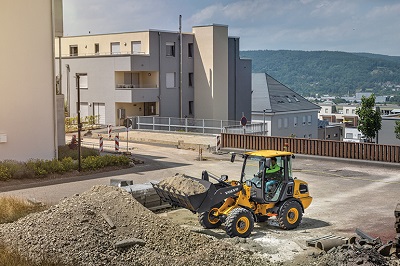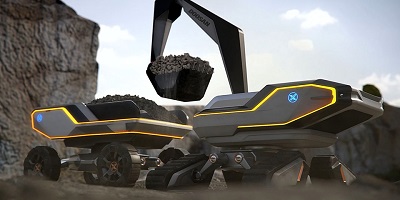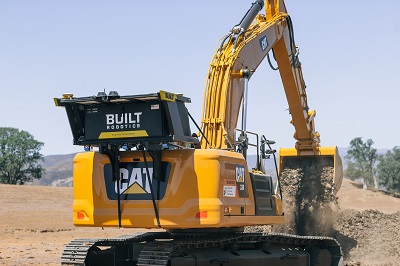Upwards of 100,000 visitors at this year’s Conexpo/IFPE will get a close-up look at hundreds of new and forward-looking construction and mining machines, along with the latest products and systems from fluid power manufacturers large and small. To better understand what the future of the mobile-equipment industry holds, and how it will impact fluid power, here’s a quick look at five major trends attendees should plan to explore.
Hybrid hydraulic-electric equipment
Battery-powered construction equipment may have been a novelty a few years ago, but growth in this sector has been on a steady rise and will represent a significant theme at Conexpo 2023. Numerous OEMs, aiming to hit sustainability goals or meet carbon-reduction regulations, will be showcasing new prototypes, commercial products and expanded “fossil-free” fleets.

As just a few examples: Volvo CE will offer two large operating arenas in its booth for electric machines, including small excavator and loader models, the new 23-ton EC230 Electric mid-size excavator and the DD25 Electric asphalt compactor. Caterpillar has announced four battery electric machine prototypes including mini and medium excavators, a compact wheel loader and a mid-size wheel loader. All include onboard ac chargers, and the company also plans to offer an offboard dc fast-charging option.
LiuGong’s introductions include two new battery electric vehicles. Wacker Neuson will display an array of zero-emission excavators, wheel loaders, and paving equipment. Manitou is launching a line of electrified telehandlers: two rotating units and a compact telehandler. And Hitachi Construction Machinery Americas will be showing its ZX55U-6EB electric compact excavator, new to the North American market.
The question for machine designers and fluid power engineers, has the combustion engine on such units merely been swapped out for an electric motor and battery pack, while the conventional hydraulics remains unchanged? Or are OEMs and systems suppliers revamping the hydraulics with high-efficiency components, state-of-the-art controls and innovative circuit designs, leading to better performance and longer run time between battery recharges?
Pure electric machines
In contrast with electrically powered hydraulic machines, a few companies are making waves with electric machines that totally eliminate hydraulics and instead rely on electromechanical actuators and electric traction drives. Can these vehicles match the performance of fluid-power based designs, stand up to rigors of construction sites, and not break the bank?
Last year, Bobcat unveiled the world’s first all-electric compact loader, the T7X. According to company officials, it offers the benefits of eliminating hydraulic systems, emissions and vibrations while providing cleaner, quieter operation. They say the unit provides high torque and more power than similar diesel-fueled track loaders and, because it does not emit exhaust, makes it excellent for enclosed jobsites. The T7X reportedly can work for up to four hours continuously and run for a normal, full day of operation during intermittent use. And the electromechanical actuators are said to be extremely durable devices suitable for use in harsh industrial applications.
Some experts, however, question the machine’s viability and performance. Among the concerns: eliminating compliant hydraulic systems can send tremendous shock loads through the system, affecting reliability and operator safety. Ball screws can also be susceptible to dirt and contamination issues, and make energy recovery challenging. And while the T7X loader will cost nearly 90% less to operate, it is priced about three times that of a comparable diesel unit.
Moog Construction, which has partnered with Bobcat, is another Conexpo exhibitor focused on accelerating electrification and zero emissions. The company has previously electrified and automated flight simulators, space launch vehicles, and material handling machinery, and is now bringing motion-control technology expertise to the construction industry.
It partnered with Komatsu to build a fully electric compact wheel loader (which will be on display at the show) again with no hydraulics. Instead, the system includes electric cylinders for the lift, tilt and steering functions; an electric traction motor that replaces the transmission, and various software-generated gear ratios approximate the operator’s traditional drive feel. It allows Komatsu to integrate elements of automation more seamlessly into machine operations.
Autonomous machines
It’s no secret that the construction and mining industries, and equipment manufacturers, are faced with some daunting issues. Among them, a shortage of skilled workers that will be getting worse as experienced operators and technicians reach retirement age. There are worries that this shortage, and the hiring of untrained and inexperienced workers to replace them, will hurt productivity and safety.

To address these concerns, a number of OEMs are developing semi-autonomous and autonomous vehicles to assist operators with precise, repetitive and boring tasks, or to replace the driver altogether. That will likely require adding “smart” hydraulic actuators, sensors, electronically controlled valves and pumps, and sophisticated control systems to all kinds of machines.
Perhaps the most notable applications to date are autonomous mining haul trucks from Caterpillar and Komatsu. They have run successfully for more than a decade, with each company reporting well over two billion tons of surface material moved by hundreds of haul vehicles in driverless operations.
With experience involving fully autonomous mining trucks, Cat is now targeting autonomous work in the construction industry. The Cat Command system has mainly been used to remotely control mining and quarrying machines, but is expanding to hydraulic excavators and dozers.
Komatsu intelligent Machine Control, first introduced about 10 years ago, is said to significantly improve safety, precision and efficiency across the entire construction site. Factory installed on both dozers and excavators, so-called “intelligent” dozers can perform in automatic mode from rough dozing to high-precision finish grading. Add-on components for machine control typically include a cab-top GNSS antenna, an enhanced inertial measuring unit, and stroke-sensing hydraulic cylinders. Machines equipped with intelligent Machine Control are said to improve productivity by 30%.
Volvo has established its Autonomous Solutions business unit to commercialize autonomous transport operations. Initial applications were in quarries, which have clearly defined loading and unloading locations over generally short distances, using an autonomous and electrically powered TA15 load carrier. The driverless machine’s automation system uses GPS, lidar, radar and multiple sensors, along with more-traditional actuators for hydraulic functions. The company is now exploring the use of autonomous construction machines in underground mining and on large earthmoving projects.
Among others that have entered the field, Teleo is developing autonomous technology to retrofit contractors’ existing heavy equipment and turn them into semi-autonomous robots. Operators can control multiple machines from a desk, which should increase productivity, safety, and operator satisfaction.
Develon (formerly Doosan Infracore) aims to innovate the construction machinery industry and enhance customer value through digital transformation. The Concept-X project will maximize worksite productivity using autonomous equipment and site analysis technologies, including artificial intelligence. Concept-X equipment provides an unmanned/automated solution that analyzes captured data to achieve accurate and fast work, monitor component status, enable efficient operation and reduce costs. The autonomous technology will be well-suited for tasks in inaccessible or hazardous areas.

A company called Built Robotics wants to tackle industry-wide workforce problems by developing software and sensors that can transform off-the-shelf excavators into machines that autonomously dig precisely for hours without a break. They’ve taken the latest sensors from self-driving cars, retrofitted them into proven equipment from the jobsite, and developed autonomous software designed specifically for construction and earthmoving requirements. A step above remotely operated vehicles, the Built Robotics system is intended to be autonomous — transforming any excavator into an autonomous trenching robot. As a plus, the system is compatible with mid-size equipment from all leading manufacturers. Installation is said to take only a few hours and is fully reversible.
Hydraulic efficiency and energy regeneration
As the growth and acceptance of battery-electric vehicles gains ground, the efficiency of hydraulic systems becomes critical. In a conventional diesel-powered machine, most of the combustion energy is wasted as heat or exhaust and inefficient hydraulics are barely noticeable. In electric vehicles, it’s a big deal. Poor performing hydraulics, among other things, means equipment have short operating run-times before they must be recharged. And battery packs must larger, which adds significant costs, increases weight, and hurts payload and overall performance.
Thus, an overriding question: Will hydraulics suppliers at IFPE be pushing the technology envelope with new and innovative offerings? For instance, look for hydraulic hose and connectors designed to reduce system losses; 3D-printed manifolds that streamline flow passages; hydraulic fluids formulated to increase operating efficiency; electronically controlled valves that deftly manage pressure and flow; innovative high-efficiency pumps, like floating-cup, digital-displacement, and low-loss internal gear designs; and low-friction dynamic seals that increase cylinder performance.
Add to that are system concepts that intelligently combine such building blocks and sizably improve efficiency. A few examples include common pressure rail and multi pressure rail systems, decentralized motor-driven actuators, valveless systems and multi-chamber actuators, to name a few.
Another problem OEMs may address is recovering energy that is typically wasted, such when an excavator lowers its bucket. Companies like Cat and Volvo have developed hydraulic hybrid excavators that capture and reuse the energy from the vehicle swing function; others have recovered and stored energy in ultracapacitors.
Sennebogen has successfully built material handlers that store previously wasted energy when lowering a boom in the form of high-pressure fluid in banks of accumulators. In the company’s innovative Green Hybrid system, this accumulated energy is then provided during the next stroke, reducing energy consumption by up to 30%.
Astute visitors should look “under the hood” at the newest machines and latest hydraulics and controls on display, to view where high-efficiency systems are headed, who’s leading the pack, and who’s maintaining the status quo.
Alternatives to batteries
As noted above, there’s significant momentum in the push for battery-electric construction equipment. But without a major breakthrough in battery technology, future electric machines seem confined mainly to small to mid-size units.
While emissions free, a major problem with battery-powered machines is energy density. In terms of MJ/liter, diesel fuel has about 18 times the energy density of today’s best lithium-ion batteries. That means electric vehicles must carry less payload, have lower performance, or stop to “refuel” more frequently than an equivalent diesel machine.
Thus, many OEMs and engine manufacturers are feverishly working on sustainable alternatives to diesel internal combustion. Successful implementation may lessen the need for ultrahigh-efficiency hydraulics, and help extend the useful life of many contemporary fluid-power designs
The wide range of applications served by diesel-powered machinery today makes it highly probable that there will not be one single alternative fuel that will replace diesel in the future. Possible options include:
Biodiesel fuels from sustainably produced organic raw materials enable a largely closed CO2 cycle. Compared to fossil fuels, biofuels in large part compensate the greenhouse gas effect of CO2 emissions generated by combustion in standard engines.
Hydrogenated vegetable oil (HVO) is a renewable diesel which can be produced from various vegetable oils and fats. Overall, it has similar chemical properties as fossil diesel, although it has a lower energy content than fossil diesel.
E-fuels are synthetic fuels (gas or liquid) made from water and carbon dioxide. Water electrolysis powered by renewably generated electricity produces oxygen and hydrogen, which then reacts with CO2 to form a synthetic gas. Energy density is considerably higher than in current batteries.
Hydrogen produced by renewable-energy based on electrolysis of water is being tested as a fuel for combustion engines and fuel cells. Fuel cells operate without emissions, although they have not been proven for use in construction machinery operating in demanding environments.
Green ammonia production generally uses the conventional Haber-Bosch process, but relies on water electrolysis and alternative energy sources. Some manufacturers are researching it as a high energy density alternative to diesel.
OEMs and engine manufacturers are thus, looking into options that combine the sustainability benefits of pure electric drives with the power of traditional diesel. Cummins, for example, will display its new “fuel-agnostic” engine platform at Conexpo. The 15-liter next-generation engine uses a common base engine and fuel systems specifically tailored for hydrogen, natural gas, and biofuels including HVO.
Kubota is paving its path toward carbon neutrality, led by a trailblazing 3.8-liter hydrogen engine and other new engine developments said to take advantage of carbon-free fuels.
Liebherr is exploring a wide range of potential fuels for mobile equipment, including hydrogen, ammonia, e-fuels, methanol, hydrogenated vegetable oil (HVO) and biodiesel, as well as electric drives. The company officials is intentionally pursuing an approach that is neutral to all technologies, because the choice of the most practical and possibly emission-free solution depends on multiple factors, including equipment size, degree of mobility, duty cycle, and the available infrastructure.
Filed Under: Mobile Hydraulic Tips